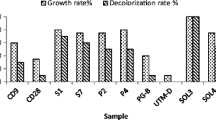Abstract
A bacterium Stenotrophomonas sp. TRMK2 capable of utilizing cinnamic acid was isolated from agro-industrial waste by enrichment culture technique. This strain completely utilizes 5 mM cinnamic acid within 18 h of incubation. The different metabolites formed during the degradation of cinnamic acid were characterized by GC-HRMS. The involvement of various enzymes, namely cinnamate reductase, 3-phenylpropionic acid hydroxylase, p-hydroxybenzoic acid hydroxylase and protocatechuate 3,4-dioxygenase in cinnamic acid degradation was demonstrated. A catabolic pathway for cinnamic acid in Stenotrophomonas sp. TRMK2 is as follows: Cinnamic acid; 3-Phenylpropionic acid; 3-(4-Hydroxyphenyl) propionic acid; 4-Hydroxy benzoic acid and Protocatechuic acid. Further, this strain is capable of utilizing various phenolic compounds.



Similar content being viewed by others
References
Akin DE, Borneman WS, Rigsby LL, Martin AS (1993) Coumaroyl and feruloyl arabinoxylans from plant cell walls as substrates for ruminal bacteria. Appl Environ Microbiol 59:644–647
Andreoni V, Bestetti G (1986) Comparative analysis of different Pseudomonas strains that degrade cinnamic acid. Appl Environ Microbiol 52:930–934
Andreozzi R, Caprio V, D’Amore MG, Insola A (1995) Coumaric acid abatement by ozone in aqueous solution. Water Res 29:1–6
Blakley ER, Simpson FJ (1964) The microbial metabolism of cinnamic acid. Can J Microbiol 10:175–185
Cartwright NJ, Smith ARW (1967) Bacterial attack on phenolic ethers: An enzyme system demethylating vanillic acid. Biochem J 102:826–841
Chamkha M, Labat M, Bharat KCP, Garcia JL (2001) Isolation of a cinnamic acid metabolizing Clostridium glycolicum strain from oil mill wastewaters and emendation of the species description. Int J Syst Evol Microbiol 51:2049–2054
Chen LH, Yang XM, Raza W, Junhua L, Yanxia L, Meihua Q, Fengge Z, Qirong S (2011a) Trichoderma harzianum SQR-T037 rapidly degrades allelochemicals in rhizospheres of continuously cropped cucumbers. Appl Microbiol Biotechnol 89:1653–1663
Chen Y, Peng Y, Dai CC, Qun J (2011b) Biodegradation of 4-hydroxybenzoic acid by Phomopsis liquidambari. Appl Soil Ecol l51:102–110
Coulson CB, Evans WC (1959) Microbiological degradation of trans-cinnamic acid by soil Pseudomonas. Chem Ind 17:543–544
Dagley S, Chapman PJ, Gibson DT (1965) The metabolism of p-phenylpropionic acid by an Achromobacter. Biochem J 97:643–650
Di Gioia D, Bertin L, Fava F, Leonardo M (2001) Biodegradation of hydroxylated and methoxylated benzoic, phenylacetic and phenylpropionic acids present in olive mill wastewaters by two bacterial strains. Res Microbiol 152:83–93
Díaz E, Ferrández A, Prieto MA, José LG (2001) Biodegradation of Aromatic compounds by Escherichia coli. Appl Environ Microbiol 65:523–569
Ding J, Sun Y, Xiao CL, Kai S, Yan HZ, Jing QY (2007) Physiological basis of different allelopathic reactions of cucumber and fig leaf gourd plants to cinnamic acid. J Exp Bot 58:3765–3773
Hartley RD, Whitehead DC (1985) Phenolic acids in soils and their influence on plant growth and soil microbial processes. In: Vaughan D, Malcolm RE (eds) Soil organic matter and biological activity, developments in plant and soil sciences series, 16. Kluwer Academic Publishers, Dordrecht
Hilton MD, Cain WJ (1990) Bioconversion of cinnamic acid to acetophenone by a Pseudomonad: microbial production of a natural flavour compound. Appl Environ Microbiol 56:623–627
Isidori M, Lavorgna M, Nardelli A, Parrella A (2004) Chemical and toxic evaluation of a biological treatment for olive-oil mill wastewater using commercial microbial formulations. Appl Microbiol Biotechnol 64:735–739
Kawakami H (1980) Degradation of lignin-related compounds by several Pseudomonads. In: Kirk TK, Higuchi T, Chang HM (eds) Lignin biodegradation: microbiology, chemistry, and potential applications, 2. CRC Press, Inc., Boca Raton, pp 103–125
Lane DJ (1991) Small subunit ribosomal RNA sequences and primers. Large subunit ribosomal RNA sequences and primers. In: Stackebrandt E, Goodfellow M (eds) Nucleic acid techniques in bacterial systematics, Wiley, Chichester, pp 148–175
Lowry OH, Rosebrough NJ, Farr AL (1951) Protein measurement with the folin phenol reagent. J Biol Chem 193:265–275
MacDonald DL, Stanier RY, Ingraham JL (1954) The enzymatic formation of β-carboxymuconic acid. J Biol Chem 210:809–820
Monisha TR, Mukram I, Kirankumar B, Pooja VR, Anand SN, Karegoudar TB (2017) Utilization of phenylpropionoids by newly isolated bacterium Pseudomonas sp. TRMK1. Appl Biochem Biotechnol 182:1240–1255
Nali M, Rindone B, Tollari S, Anderoni V, Treccani V (1985) Anaerobic microbial conversion of three hydroxycinnamic acids. Experientia 41:1351–1353
Santoshkumar M, Veeranagouda Y, Lee K, Karegoudar TB (2011) Utilization of aliphatic nitrile by Paracoccussp. SKG isolated from chemical waste samples. Int Biodeter Biodegr 65:153–159
Seidman MM, Toms A, Wood JM (1969) Influence of side-chain substituents on the position of cleavage of the benzene ring by Pseudomonas fuorescens. J Bacteriol 97:1192–1197
Sepic E, Bricelj M, Leskovsek H (1998) Degradation of fluoranthene by Pasteurella sp. IFA and Mycobacterium sp. PYR-1: isolation and identification of metabolites. J Appl Microbiol 85:746–754
Singh NB, Yadav K, Amist N (2013) Phytotoxic effects of cinnamic acid on cabbage (Brassica oleracea var. capitata). J Stress Physiol Biochem 92:307–317
Sleat R, Robinson JP (1984) The bacteriology of anaerobic degradation of aromatic compounds. J Appl Bacteriol 57:381–394
Suarez M, Martín M, Ferrer E (1995) Purification and characterization of 4-hydroxybenzoate 3-hydroxylase from a Klebsiella pneumoniae mutant strain. Arch Microbiol 164:70–77
Subba Rao PV, Nambudiri AMD, Bhat JV (1971) Microbial degradation of phenylpropionoids compounds. J Sci Ind Res 30:663–679
Whiting GC, Carr JG (1959) Metabolism of cinnamic acid and hydroxycinnamic acids by Lactobacillus pastorianusvar. quinicus. Nature 184:1427–1428
Zhang ZY, Pan LP, Li HH (2010) Isolation, identification and characterization of soil microbes which degrade phenolic allelochemicals. J Appl Microbiol 108:1839–1849
Acknowledgements
One of the authors Mr. Monisha T. R. would like to thank University Grants Commission (UGC), New Delhi, India for the financial assistance in the mode of BSR Fellowship. Dr. T. B Karegoudar is grateful to UGC for awarding UGC-BSR faculty fellowship. The financial support from UGC in the form of UGC-SAP programme [No.F.4–27/2015/DRS-II (SAP-II)] sanctioned to the department is highly acknowledged.
Author information
Authors and Affiliations
Corresponding author
Ethics declarations
Conflict of interest
Authors declare that the manuscript does not contain any conflict of interest.
Rights and permissions
About this article
Cite this article
Monisha, T.R., Ismailsab, M., Masarbo, R. et al. Degradation of cinnamic acid by a newly isolated bacterium Stenotrophomonas sp. TRMK2. 3 Biotech 8, 368 (2018). https://doi.org/10.1007/s13205-018-1390-0
Received:
Accepted:
Published:
DOI: https://doi.org/10.1007/s13205-018-1390-0




